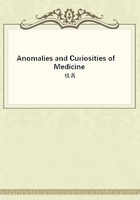
第56章
According to Aveling, Herman of Berne reports the instance of a young lady whose body was far advanced in putrefaction, from which was expelled an unbroken ovum containing twins. Even the placenta showed signs of decomposition. Naumann relates the birth of a child on the second day after the death of the mother.
Richter of Weissenfels, in 1861, reported the case of a woman who died in convulsions, and sixty hours after death an eight months'
fetus came away. Stapedius writes to a friend of a fetus being found dead between the thighs of a woman who expired suddenly of an acute disease. Schenk mentions that of a woman, dying at 5P.M., a child having two front teeth was born at 3 A.M.
Veslingius tells of a woman dying of epilepsy on June 6, 1630, from whose body, two days later, issued a child. Wolfius relates the case of a woman dying in labor in 1677. Abdominal movements being seen six hours after death, Cesarean section was suggested, but its performance was delayed, and eighteen hours after a child was spontaneously born. Hoyer of Mulhausen tells of a child with its mouth open and tongue protruding, which was born while the mother was on the way to the grave. Bedford of Sydney, according to Aveling, relates the story of a case in which malpractice was suspected on a woman of thirty-seven, who died while pregnant with her seventh child. The body was exhumed, and a transverse rupture of the womb six inches long above the cervix was found, and the body of a dead male child lay between the thighs. In 1862, Lanigan tells of a woman who was laid out for funeral obsequies, and on removal of the covers for burial a child was found in bed with her. Swayne is credited with the description of the death of a woman whom a midwife failed to deliver. Desiring an inquest, the coroner had the body exhumed, when, on opening the coffin, a well-developed male infant was found parallel to and lying on the lower limbs, the cord and placenta being entirely unattached from the mother.
Some time after her decease Harvey found between the thighs of a dead woman a dead infant which had been expelled postmortem.
Mayer relates the history of a case of a woman of forty-five who felt the movement of her child for the fourth time in the middle of November. In the following March she had hemoptysis, and serious symptoms of inflammation in the right lung following, led to her apparent death on the 31st of the month. For two days previous to her death she had failed to perceive the fetal movements. She was kept on her back in a room, covered up and undisturbed, for thirty-six hours, the members of the family occasionally visiting her to sprinkle holy water on her face.
There was no remembrance of cadaveric distortion of the features or any odor. When the undertakers were drawing the shroud on they noticed a half-round, bright-red, smooth-looking body between the genitals which they mistook for a prolapsed uterus. Early on April 2d, a few hours before interment, the men thought to examine the swelling they had seen the day before. A second look showed it to be a dead female child, now lying between the thighs and connected with the mother by the umbilical cord. The interment was stopped, and Mayer was called to examine the body, but with negative results, though the signs of death were not plainly visible for a woman dead fifty-eight hours. By its development the body of the fetus confirmed the mother's account of a pregnancy of twenty-one weeks. Mayer satisfies himself at least that the mother was in a trance at the time of delivery and died soon afterward.
Moritz gives the instance of a woman dying in pregnancy, undelivered, who happened to be disinterred several days after burial. The body was in an advanced state of decomposition, and a fetus was found in the coffin. It was supposed that the pressure of gas in the mother's body had forced the fetus from the uterus.
Ostmann speaks of a woman married five months, who was suddenly seized with rigors, headache, and vomiting. For a week she continued to do her daily work, and in addition was ill-treated by her husband. She died suddenly without having any abdominal pain or any symptoms indicative of abortion. The body was examined twenty-four hours after death and was seen to be dark, discolored, and the abdomen distended. There was no sanguineous discharge from the genitals, but at the time of raising the body to place it in the coffin, a fetus, with the umbilical cord, escaped from the vagina. There seemed to have been a rapid putrefaction in this ease, generating enough pressure of gas to expel the fetus as well as the uterus from the body. This at least is the view taken by Hoffman and others in the solution of these strange cases.
Antepartum Crying of the Child.--There are on record fabulous cases of children crying in the uterus during pregnancy, and all sorts of unbelievable stories have been constructed from these reported occurrences. Quite possible, however, and worthy of belief are the cases in which the child has been heard to cry during the progress of parturition--that is, during delivery.
Jonston speaks of infants crying in the womb, and attempts a scientific explanation of the fact. He also quotes the following lines in reference to this subject:--"Mirandum foetus nlaterna clausus in alvo Dicitur insuetos ore dedisse sonos.
Causa subest; doluit se angusta sede telleri Et cupiit magnae cernere moliis opus.